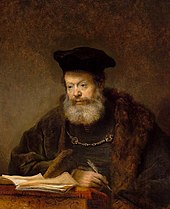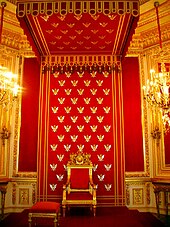Warsaw Royal Castle
| Royal Castle | ||
|---|---|---|
|
West facade from Schlossplatz |
||
| Creation time : | before 1400 | |
| Castle type : | lock | |
| Conservation status: | Reconstructed | |
| Place: | Warsaw | |
| Geographical location | 52 ° 14 '52 " N , 21 ° 0' 53" E | |
|
|
||

The Warsaw Royal Castle ( Polish: Zamek Królewski w Warszawie ) was the seat of the Polish kings until the 18th century. After the complete destruction in the Second World War by the German armed forces and by the demolition squad of the technical emergency aid , it was rebuilt from 1971 to 1988 mainly with the help of US donations. In 1980, the castle was a part of Warsaw's old town to the UNESCO - World Heritage listed.
history
Construction of a residential and defense building in the old town
The roots of the building, located in the old town in the Śródmieście district on Castle Square , go back to a fortified wooden building with a defense tower of the Dukes of Mazovia from the 13th / 14th centuries. Century back, whereby the castle hill has been permanently inhabited for over 8000 years. Two larger Gothic- style buildings ( Dwór Wielki, Dwór Mniejszy ) were built in the 15th century. From these components, Gothic walls have been preserved on the south wing of the inner courtyard, which were reconstructed during the reconstruction from the 1960s. The castle gardens between the castle and the Vistula were created around 1400 and changed in the Renaissance style in the 16th century.
After Warsaw had been designated as the permanent meeting place of the Sejm in the Lublin Union , a new royal main building in Renaissance style was built in 1570/1571 based on designs by Giovanni Battista di Quadro . King Sigismund III. moved the capital of Poland-Lithuania from Krakow to Warsaw in 1596 and had a new pentagonal castle built between 1598 and 1619, which was built by the architects Matteo Castelli (also: Castello) and Giacomo Rodondo in the Baroque style. Sigismund's son Władysław IV. Wasa had a loggia gallery built on the garden side and the Władysławowska tower named after him in the inner courtyard. This was added from 1637–1643 based on a design by Constantino Tencalla . The castle was sacked during the Swedish invasion in the middle of the 17th century. Some of the looted components were found in low water in the Vistula in 2012 .
The royal palace was rebuilt several times in the 18th century. Under the Wettin King August III. a rococo wing was built on the Vistula side in 1737–1746, which towered over the baroque palace gardens. The design came from Gaetano Chiaveri . King Stanislaus II August made special contributions to the castle . From 1765–1771 he had the palace built around the south wing by Jakob Fontana. At that time, a painting workshop was set up in the castle, which Bacciarelli ran. He himself made portraits of rulers for the precious marble cabinet. The interior of the palace was based on the classicist designs by Domenico Merlini and Jan Chrystian Kamsetzer , but there are also elements of the Rococo . Special treasures from this period include the ballroom, the senator's hall with the royal throne , which was expanded by Joachim Daniel von Jauch , and a classicist statue of Chronos by Charles Le Brun in the knight's hall , which also contains six historical paintings by Marcello Bacciarelli , and the marble hall with the portraits of the Polish kings of Marcello Bacciarelli, who were donated by Stanislaus II August . Later, the interior of the royal library was redesigned in 1814 by Wilhelm Heinrich Minter , which today is the only original room in the palace complex.
On May 3, 1791, the first modern European constitution was passed in the halls of the Sejm and Senate. History paintings by Jan Matejko , especially his masterpiece The Constitution of May 3, 1791, hang in these halls . With the partition of Poland in 1795, the castle lost all its functions as the seat of the king, the Sejm and the Senate.
After the suppression of the November Uprising in 1831, Russian troops looted the building and brought the most valuable art treasures to Saint Petersburg . Poland got part of it back after the Peace of Riga in 1921 . Since 1918 the castle has been the seat of the Polish President. In the inter-war period, next to President Gabriel Narutowicz, the candidate for the Nobel Prize for Literature, Stefan Żeromski, lived in the top hall . The restoration work ended with the outbreak of World War II .
Destruction and rebuilding
During the siege of Warsaw in September 1939, the German air force largely destroyed the castle by bombing. Then members of the Wehrmacht plundered the art treasures under the supervision of Dagobert Frey . After the suppression of the Warsaw uprising in 1944, Heinrich Himmler had the castle and large parts of the Polish capital blown up as planned .

Party leader Edward Gierek initiated the reconstruction on the basis of donations after a vote in 1971, which lasted 17 years. The model for the reconstruction of the castle, like the entire old town, were the famous Canalettos vedutas , which only illustrate the Krakowskie Przedmieście and were used for the reconstruction of this part of the historic city center. Twenty of these paintings are in the Canaletto room.
The castle was registered in 1980 together with the also rebuilt Warsaw Old Town as a Unesco World Heritage Site .
Rooms (selection)
Throne room
The small throne room with an epochal chandelier presents a copied throne chair that stands on a podium. According to the explanations for visitors, however, a lot of the original equipment has been preserved: doors, wooden panels, sculptures. Behind the throne, symmetrical rows of the silver Polish heraldic eagle in relief adorn the red wall.
Castle Church
In the castle chapel there is a capsule with the heart of the freedom fighter Tadeusz Kościuszko to commemorate the changeful fate of the country .
Ballroom
Here, the visitor particularly notices the numerous mirror surfaces.
Picture gallery

An extensive picture gallery has been located in the castle since the 1990s. Large parts of it go back to a donation from the resistance fighter, Countess Karolina Lanckorońska , who bequeathed her father's legacy to the Polish nation. Rembrandt's original paintings are noteworthy : The Girl in a Picture Frame (1641) and Scholar at his Desk (1641). Another part of the Lanckoroński collection is in the Wawel Castle in Kraków. The gallery also housed numerous views of Warsaw by Canaletto.
other rooms
One room is dedicated to the representation of Polish orders and dignitaries. The room of the Polish government in exile is also located here .
See also
literature
- MM Drozdowski, A. Zahorski: Historia Warszawy . PWN, Warsaw, 1975
- Aleksander Król: Zamek Królewski w Warszawie. Od końca XIII wieku do roku 1944 . PIW, Warsaw, 1971
- Bohdan Guerquin: Zamki w Polsce . Wydawnictwo Arkady, Warsaw, 1974
- Andrzej Rottermund: Zamek Królewski w Warszawie . Wydawnictwo Naukowe PWN, Warsaw, 2002, ISBN 83-221-0746-3
- Agnieszka Sypek, Robert Sypek: Zamki i warownie ziemi mazowieckiej . Warsaw: Wydawnictwo Trio, 2002, pp. 26–36. ISBN 83-88542-34-6 .
Web links
- Official homepage of the Warsaw Royal Castle
- Interactive panorama: Warsaw Royal Castle
- Supplementary article with photos: The Royal Castle in Warsaw - like a phoenix from the ashes
Individual evidence
- ^ Peter K. Gessner: Warsaw's Royal Castle and its destruction during the Second World War . In: info-poland.buffalo.edu . Archived from the original on May 10, 2008. Retrieved July 23, 2008.
- ↑ Wehrmacht crimes versus the myth of a "cleaner" campaign - ORF ON Science . Retrieved May 28, 2011.
- ↑ see photo at https://commons.wikimedia.org/wiki/File:Preparation_for_Destruction_of_Royal_Castle_in_Warsaw.jpg ; which comes from an Alfred Mensebach photo album and was taken on September 8th, 1944. Edward Serwański, Irena Trawińska (red.): Zbrodnia niemiecka w Warszawie 1944 r. Poznań: Wydawnictwo Instytutu Zachodniego, 1946





